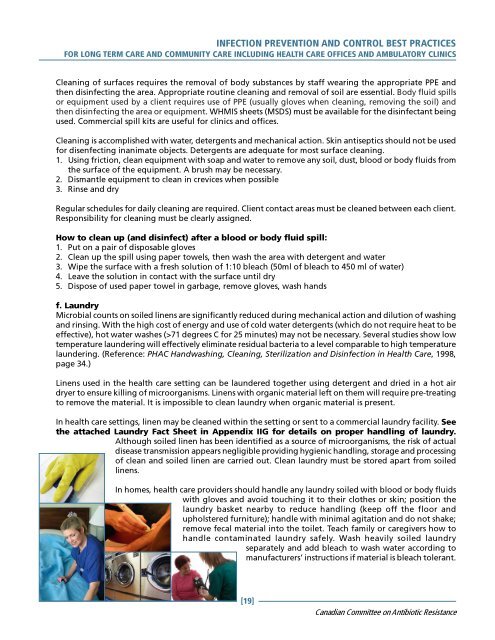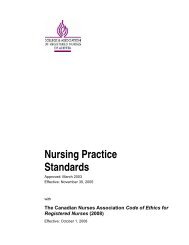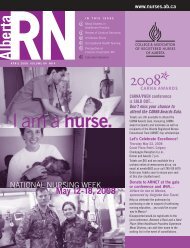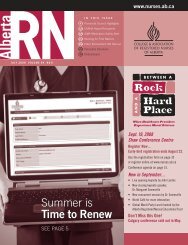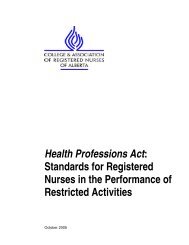Infection Prevention and Control Best Practices - College ...
Infection Prevention and Control Best Practices - College ...
Infection Prevention and Control Best Practices - College ...
You also want an ePaper? Increase the reach of your titles
YUMPU automatically turns print PDFs into web optimized ePapers that Google loves.
INFECTION PREVENTION AND CONTROL BEST PRACTICES<br />
FOR LONG TERM CARE AND COMMUNITY CARE INCLUDING HEALTH CARE OFFICES AND AMBULATORY CLINICS<br />
Cleaning of surfaces requires the removal of body substances by staff wearing the appropriate PPE <strong>and</strong><br />
then disinfecting the area. Appropriate routine cleaning <strong>and</strong> removal of soil are essential. Body fluid spills<br />
or equipment used by a client requires use of PPE (usually gloves when cleaning, removing the soil) <strong>and</strong><br />
then disinfecting the area or equipment. WHMIS sheets (MSDS) must be available for the disinfectant being<br />
used. Commercial spill kits are useful for clinics <strong>and</strong> offices.<br />
Cleaning is accomplished with water, detergents <strong>and</strong> mechanical action. Skin antiseptics should not be used<br />
for disenfecting inanimate objects. Detergents are adequate for most surface cleaning.<br />
1. Using friction, clean equipment with soap <strong>and</strong> water to remove any soil, dust, blood or body fluids from<br />
the surface of the equipment. A brush may be necessary.<br />
2. Dismantle equipment to clean in crevices when possible<br />
3. Rinse <strong>and</strong> dry<br />
Regular schedules for daily cleaning are required. Client contact areas must be cleaned between each client.<br />
Responsibility for cleaning must be clearly assigned.<br />
How to clean up (<strong>and</strong> disinfect) after a blood or body fluid spill:<br />
1. Put on a pair of disposable gloves<br />
2. Clean up the spill using paper towels, then wash the area with detergent <strong>and</strong> water<br />
3. Wipe the surface with a fresh solution of 1:10 bleach (50ml of bleach to 450 ml of water)<br />
4. Leave the solution in contact with the surface until dry<br />
5. Dispose of used paper towel in garbage, remove gloves, wash h<strong>and</strong>s<br />
f. Laundry<br />
Microbial counts on soiled linens are significantly reduced during mechanical action <strong>and</strong> dilution of washing<br />
<strong>and</strong> rinsing. With the high cost of energy <strong>and</strong> use of cold water detergents (which do not require heat to be<br />
effective), hot water washes (>71 degrees C for 25 minutes) may not be necessary. Several studies show low<br />
temperature laundering will effectively eliminate residual bacteria to a level comparable to high temperature<br />
laundering. (Reference: PHAC H<strong>and</strong>washing, Cleaning, Sterilization <strong>and</strong> Disinfection in Health Care, 1998,<br />
page 34.)<br />
Linens used in the health care setting can be laundered together using detergent <strong>and</strong> dried in a hot air<br />
dryer to ensure killing of microorganisms. Linens with organic material left on them will require pre-treating<br />
to remove the material. It is impossible to clean laundry when organic material is present.<br />
In health care settings, linen may be cleaned within the setting or sent to a commercial laundry facility. See<br />
the attached Laundry Fact Sheet in Appendix IIG for details on proper h<strong>and</strong>ling of laundry.<br />
Although soiled linen has been identified as a source of microorganisms, the risk of actual<br />
disease transmission appears negligible providing hygienic h<strong>and</strong>ling, storage <strong>and</strong> processing<br />
of clean <strong>and</strong> soiled linen are carried out. Clean laundry must be stored apart from soiled<br />
linens.<br />
In homes, health care providers should h<strong>and</strong>le any laundry soiled with blood or body fluids<br />
with gloves <strong>and</strong> avoid touching it to their clothes or skin; position the<br />
laundry basket nearby to reduce h<strong>and</strong>ling (keep off the floor <strong>and</strong><br />
upholstered furniture); h<strong>and</strong>le with minimal agitation <strong>and</strong> do not shake;<br />
remove fecal material into the toilet. Teach family or caregivers how to<br />
h<strong>and</strong>le contaminated laundry safely. Wash heavily soiled laundry<br />
separately <strong>and</strong> add bleach to wash water according to<br />
manufacturers’ instructions if material is bleach tolerant.<br />
[19]<br />
Canadian Committee on Antibiotic Resistance


